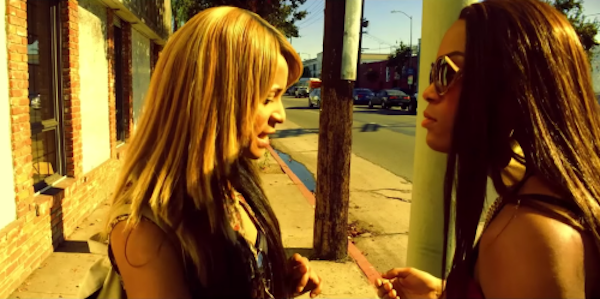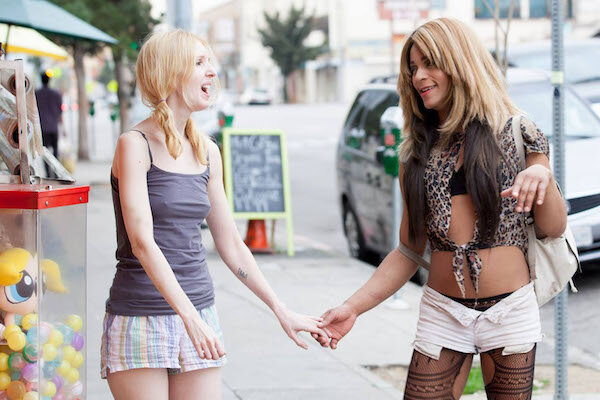Moments of anger, confusion, passion and joy are lensed in bright colours in Sean Baker’s Tangerine. The filmmaker’s unconventional Christmas movie maps its characters emotions through the hues that the audience can latch onto – and it’s also testament to a long history of queerness communicated through colour, at once bright and vivid and often complicated. Kristina Murkett explores the psychology of the film through her own colour reading.
In Scene 3 of A Streetcar Named Desire, Tennessee Williams sets the stage by comparing the setting to Van Gogh’s painting The Night Café. Williams describes in close detail how the stage is awash with a “lurid nocturnal brilliance” and “the raw colours of childhood’s spectrum.” There is the “yellow linoleum of the kitchen table,” the “electric bulb with a vivid green glass shade,” the “vivid slices of watermelon and whiskey glasses,” and the men in their “coloured shirts” jostling as they prepare for their poker night.
The tension is palpable; there is an “absorbed silence” as the first hand is dealt. The scene does not end well; one of the poker players, Stanley Kowalski, flies into a drunken rage and beats his pregnant wife Stella, whilst her sister Blanche watches on helplessly. One of Stanley’s buddies, Mitch, simply repeats, “Poker should not be played in a house full of women.”
Colour, here, represents many things: danger, intense emotions, and a vitality that can easily transform into violence. The same can be said of Sean Baker’s 2015 comedy-drama Tangerine.
Like A Streetcar Named Desire, Tangerine has a tripartite focus, following three main characters: Sin-Dee, a transgender sex worker recently released from prison and looking for her pimp/boyfriend Chester’s side-piece; Alexandra, another transgender sex worker who, rather depressingly, also pays to sing in bars; and Razmik, an Armenian cab driver who is married and has a child but spends his evenings picking up sex workers. It takes place over 24 hours in Los Angeles on Christmas Eve – making this one of the more unusual festive movies.
The film was shot on a modified iPhone 5S with an anamorphic adaptor, which allows every frame to capture the expanse of the LA landscape. As the characters walk from donut joints to Laundromats to taco restaurants to taxi ranks to brothels to buses, we experience this sprawling urban metropolis in all its artificiality. Everything is bathed in super-saturated reds, greens, and oranges; from the lurid yellow table in the opening credits to Sin-Dee’s marigold wig, to the marmalade air freshener in Razmik’s taxi – the environment is seemingly as colourful as its characters.
The abundance of colour in the film has a two-fold effect. Firstly, it creates a sense of drug-tinged hyper-reality; everything is so raw, vivid and intense that it is almost dream-like. When filmmakers first started to hand paint colour onto film stock in the early 1900s, they did so in order to create a distancing effect, rather than to make scenes more lifelike. This relationship between colour and artificiality is something Sean Baker was well aware of.
In an interview with Seventh Row, Baker describes how “audiences associate desaturation with reality.” He said, “When you saturate the colours… sometimes, that can look very amateurish and cheap,” or “too manicured, too perfect, too beautifully lit.” However, when they “added grain and the proper colour correction” post-production, “it just gave a vibrancy that made the colours pop.”
The grain is particularly important because it creates a world both glowing and gaudy, bright but garish, rich but also cheap. The film is bathed in warm light, but the sun is also low, as if constantly setting, and this visual duality reflects the film’s thematic one: this is an LA full of joy and friendship, but also betrayal, homophobia, and precarious poverty.
This riotous colour also emphasises the anarchic looseness of Sin-Dee’s carnage-causing stomp around LA; as one of her friends remarks, she’s out of jail for “24 hours” and hell-bent on “causing drama.” Actress Kitana Kiki Rodriguez perfectly captures Sin-Dee’s unkempt, freewheeling, improvisatory style, as she ranges from explosive anger to outrageous flirting in her desperate attempt to find Dinah, the ‘fish’ (a derogatory term for a cisgender woman) who has been sleeping with her boyfriend.
Sin-Dee may be zesty in her energy and enthusiasm, but her behaviour takes a bittersweet turn when she does finally find Dinah. She drags her – literally – to find Chester, and in the process Dinah is beaten, bruised, insulted, slapped, and forced to walk around with only one shoe on. The two do eventually become friends, but that does not make re-watching their exchange any less uncomfortable.
Like Stanley from A Streetcar Named Desire, Sin-Dee is a complicated, vivacious character whose dynamism goes too far. She is not a sadist like Stanley, but she does have the same salt-of-the-earth assertiveness. Williams describes Stanley’s masculine energy as “coarse and powerful and direct as the primary colours”; Sin-Dee’s feminine energy seems to be all of those things too.
As warm and likeable as she may be, it is hard to reconcile this with the fact that she is also a character who kicks down doors, knocks over a homeless man’s food, and revels later when Razmik’s wife finds out about his illicit activities.
Dinah is the outsider of the film, both socially and visually: she is the only character who is not aesthetically or thematically associated with colour. All the other characters are surrounded by bright hues: Chester wears a garishly bright blue hoodie; Razmik lives in an apartment with mustard-coloured walls; Alexandra dons a bright red dress and lipstick when she sings.
Dinah is colourless. Sin-Dee finds her in a brothel so dimly lit it is almost monochromatic; all white walls, grey sheets and dark spaces. Everything about Dinah is ashen: she is so pale she almost seems anaemic, she has very fair blonde hair, she wears white pyjama shorts, and wears no make-up except for some smudged eyeliner. It is probably no coincidence that Dinah is also one of the very few characters in the film who is not queer.
Queerness has long been associated with colour: in the late 1800s, homosexual men wore green carnations in order to subtlely identify each other (Oscar Wilde famously wore one). During the twentieth century, this changed to red ties and cravats, and red eventually became a symbol of the AIDS awareness movement. In the 1950s, homosexual men were referred to as “lavender lads”, which led to the “Lavender Scare,” a moral panic against homosexual people and their mass dismissal from government service. In the 1970s the pink triangle, once used as a way for Nazi soldiers to identify homosexual prisoners, was reclaimed as a symbol of LGBT pride, and in 1978 Gilbert Baker designed the LGBTQ+ rainbow flag.
Colour has always been an integral part of the gay rights’ movement, but Dinah is not part of the queer world that Alexandra and Sin-Dee inhabit. There is no doubt that Dinah has her own struggles – there is a particularly poignant moment at the end of the film when she is told by her madame that she has been replaced – but her heterosexuality sets her apart from the others.
Many queer movies use colour to show intensity of emotion and freedom of self-expression. Portrait Of A Lady On Fire uses complementary reds and greens to show the protagonists’ magnetic attraction (much in the same way Alfred Hitchcock did in Vertigo). Moonlight and Blue Is The Warmest Colour both utilise blue as a way of expressing both masculine and feminine attributes in their protagonists.
When Baker designed the LGBTQ+ flag, he wanted the colours to symbolise not only the mixed spectrum of sexualities and genders in the community, but also vital elements of life: vitality (red), healing (orange), sunlight (yellow), nature (green), harmony (blue) and spirit (purple). The blues in Moonlight and Blue Is the Warmest Colour also evoke the unity Baker envisioned, as both films are bildungsromans exploring the reconciliation of inner conflicts.
Dee Rees’ Pariah, which won the Excellence in Cinematography Award at the Sundance Film Festival in 2011, also uses colours to reflect a protagonist coming of age. The film focuses on Alike, a 17 year old African-American whose conservative family background means that she struggles to accept herself as a lesbian. The first half of the film is awash with pinks, which symbolises her innocence and struggle to hold onto traditionally ‘female’ values. The second half is then dominated by cyans, mapping her transition to a more experienced, reconciled state, once again reinforcing the connection between blue and harmony.
Tangerine stands out, though, for the way in which colour shows both beauty and brutality. In many respects it is not as visually pleasing as these other films; at times lurid, harsh, even discordant. Nonetheless, it reflects a reality rarely seen on screen, in all its multi-coloured, multidimensional, multi-gendered glory.
Its omnipresent oranges also remind us of the need for healing in a fragile world. The storyline may centre around Sin-Dee trying to save her relationship with Chester, but the ending actually focuses on the importance of Sin-Dee and Alexandra’s friendship. In the final scene, Sin-Dee and Alexandra sit under the neon lights of a laundrette, and Alexandra lets Sin-Dee borrow her wig after she suffers a homophobic attack, a gesture that helps to heal the rift in their relationship.
This small act of kindness reminds us of Alexandra’s solace and support throughout the movie, and how friendship soothes and softens Sin-Dee’s fiery temperament. It also reminds us that healing, like all these oranges throughout the film, may not be pretty – but it is always powerful.
Kristina (@kristinamurkett) is an Oxford English graduate, qualified teacher and freelance writer. She has written for The Spectator, Little White Lies, The Quietus, Screen Queens, The Film Magazine and others; she also reviews books and films on her Instagram blog, @cultureinthetimeofcorona.




